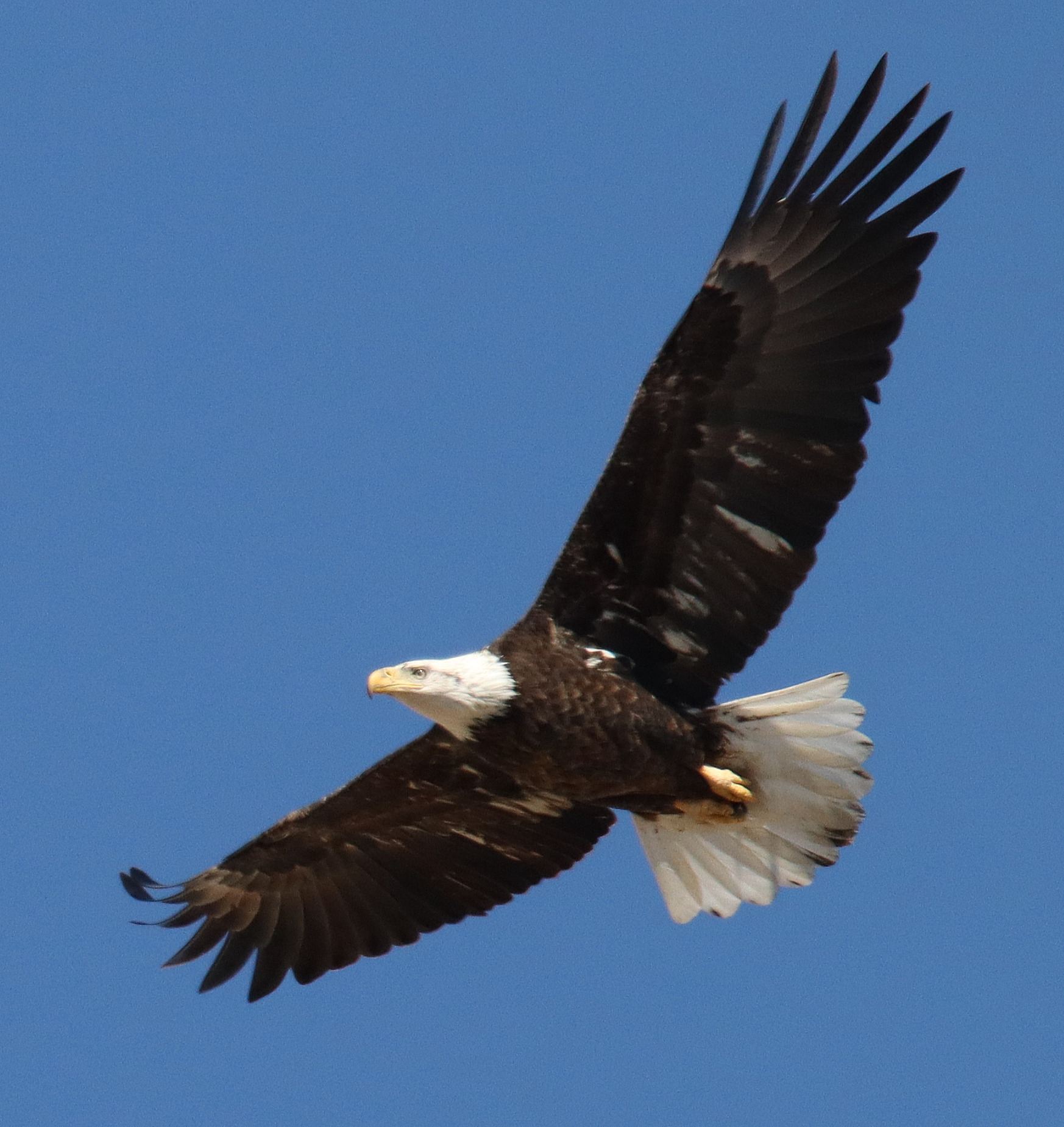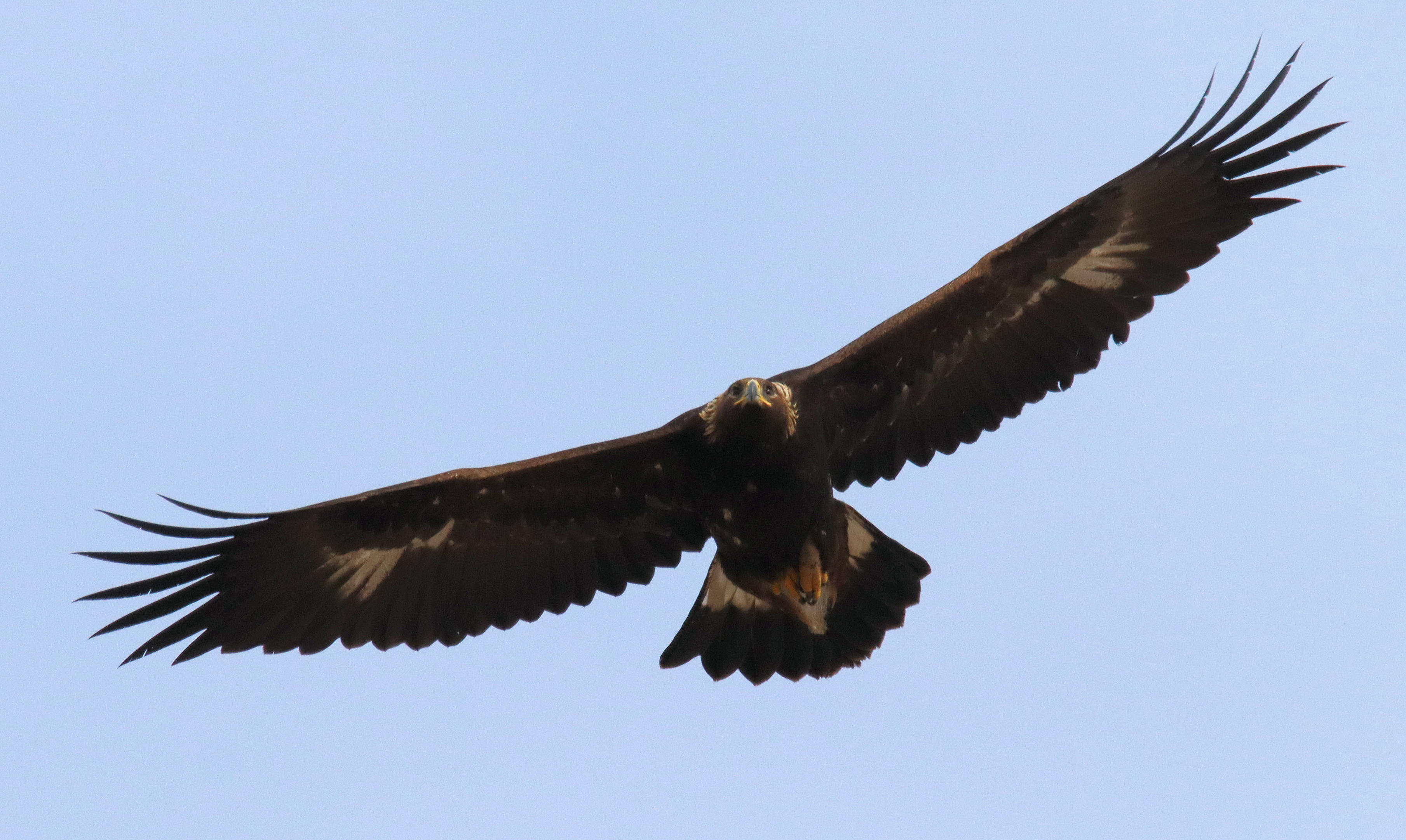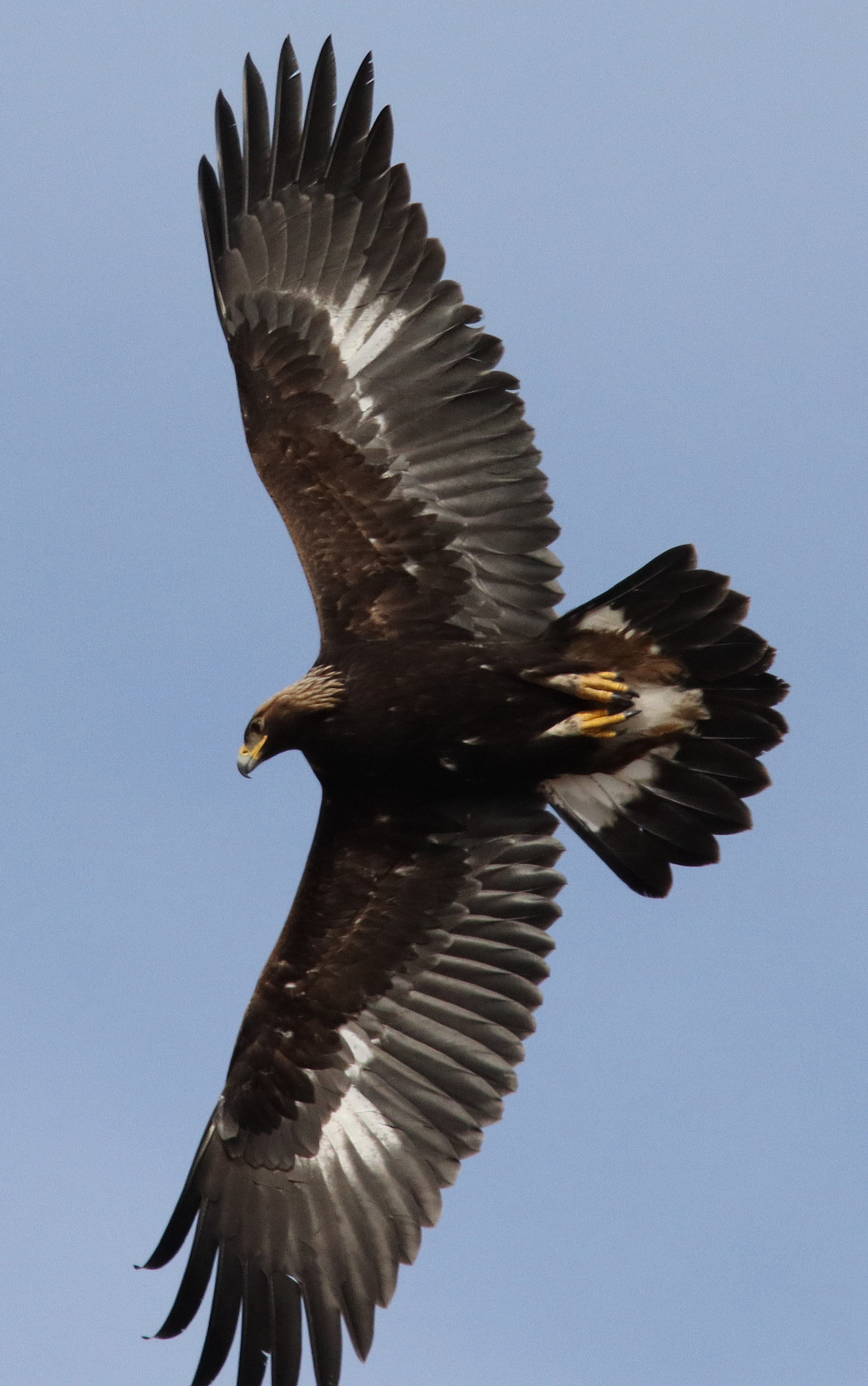
The first migrating Bald Eagle of the spring season was a momentary surprise that yielded a few photos when we crossed paths, me headed west, the eagle headed north.

A gliding Golden Eagle provided memorable encounters last Thursday, eventually joining a second yearling in a memorable aerial performance.

When least expected, as it was gliding horizontally the young male Golden Eagle suddenly made super-quick unwarranted downward turn that highlighted its underside in the afternoon sunlight before rising upward again into another glide. The action was quick and spectacular in the midst of its otherwise tranquil gliding flights.
|
Inspired by a dramatic change in weather last week, I began a search for the first birds of spring. The flocks of snow birds – Snow Buntings and Horned Larks – left the region, perhaps the state, so where and when would their replacements appear? I began with a drive to Sand Lake National Wildlife Refuge, 70 miles southeast, but only found Ring-necked Pheasants. Wednesday I headed to Fargo next, and that’s where spring birding began with 2 pairs of Giant Canada Geese and a pair of Mallards in a meltwater pool near my partridge area, along with 1 male Gray Partridge. And on the warmest day of the week, I headed west for the Missouri River, with hopes of finding more waterfowl and some migrating raptors.
The first 50 miles were empty of birds, but that changed when I caught sight of a flock of birds settling down to earth far ahead. It turned out to be a flock of 21 Canada Geese, a good omen for other migrants nearer the river. Next was the first raptor of the day, a Rough-legged Hawk that was hunting, including hovering periodically, but it was an unusual hunting style in that the hawk was hovering higher than I have ever seen before – 60 feet or higher. Usually hovering is initiated when a hawk is relatively close to the ground, say 10 or 20 feet.
Another 30 miles passed by without a bird, but as I approached the highest butte between Beaver Creek and Badger Creek, I could see a raptor soaring near the top of the flap-topped butte a short distance east of the Missouri River. Another mile provided a positive ID of a Golden Eagle, a young bird, likely a yearling, that was on the hunt before me. The butte is infamous for attracting large open-range raptors, but last fall and now it’s been something of a Golden Eagle magnet.
I ended up spending the next hour in the area of this “eagle butte,” where 3 Rough-legged Hawks passed through, climbing higher on the same thermal – a beautifully marked male, a dark morph male, and a normally colored female or yearling. After soaring higher the trio continued north, and 20 minutes later a lone female swept north on a much lower flight. But the real excitement took place when I returned to the eagle butte with a Golden Eagle in perfect position to photograph. As I was watching for the right place to position, a second eagle appeared in close proximity with the first, gliding in tandem it seemed.
I was able to drive past the eagles to a point where the sunlight was best, and even though I stood in the open, the eagles didn’t flinch as I photographed them gliding in my direction. In fact, they seemed to be attracted to my position, gliding before me, and even soaring directly overhead – close – then repeating the process, one after the other. It was an especially exciting opportunity to share time with 2 yearling Golden Eagles, and I still cherish the minutes I photographed the birds. I share a couple images here, but for the entire story and larger photographs, please take a look at this week’s Bird Photography feature.
Eventually, when the sky cleared of raptors, I continued north another dozen miles with hope of seeing other early migrants, but just one appeared – a Northern Harrier – along with a Northern Shrike. However, I also saw a Sharp-tailed Grouse and 8 male Ring-necked Pheasants feeding in groups of 1,3,1, and 1; and on the way home 3 female pheasants appeared, along with a Rough-legged Hawk on the hunt, hovering 10 feet above ground in the midst of an area I refer to as Hawk Valley for the numbers of raptors that are attracted to its complex of grasslands and marshes.
With a pretty extensive search for the first birds of spring, I appreciated a level of success in documenting the very start of spring from a bird’s standpoint, signaling the same for this enthusiastic birder, who is equally enthusiastic to pass from the coldest week of winter to the first week of spring. Indeed, meteorologists count March 1st as the first day of spring, and as far as I’m concerned, up here on the northern edge of the Lower 48, I’d go along with that fudging of the calendar.
Yard Action
Wednesday I heard a woodpecker tapping even before rising from bed, but I didn’t see one until Friday afternoon when a male Hairy Woodpecker zipped in to grab a shelled peanut and tap it into pieces that it ate while clinging to the elm tree a few feet from my feeding station. I had one other Hairy Woodpecker sighting at my platform feeder yesterday (Tuesday), a male that grabbed a bite and vanished, but returned later, 3 more times. The juncos left sometime last week – it’s always easier to tell when birds arrive than when they leave. But the other species continue to visit, including the young Harris’s Sparrow. How long before spring birds arrive at my feeders and water feature?
Saturday morning I heard a woodpecker drumming, and about noon a male Downy Woodpecker appeared on a sumac tree outside my bay windows – the first Downy of the year believe it or not – and a nice new addition to the neighborhood I hope. He didn’t visit the feeders, but poked around the sumacs a bit. Haven’t seen a male Downy since then, but I was thrilled to see a female woodpecker, finally, and it was a Downy Woodpecker too. I only managed a glance at her Monday afternoon, so I have my fingers crossed for a couple Downys to swing by again when I’m in a viewing mode.
Later, after returning from an area drive that revealed a flock of 16 Sharp-tailed Grouse, about 150 yards from home an adult Sharp-shinned Hawk flew just a couple feet above the road in front of me and zipped around a building and out of sight. I circled the area hoping to find it, but no go. Was it the same Sharpie that dropped by my feeding station last week? Probably, considering I’ve only seen 1 other Sharp-shinned Hawk in the area over the years, and they are rare even as migrants across the Northern Plains.
Return to the River
Sunday’s forecast looked like a potential breakthrough migration day with blue sky sunshine, a slight south wind and warming temperatures, so how could I resist retracing Thursday’s route to the Missouri River to see what was happening along the Missouri breaks, including “eagle butte.” An eagle was my first sighting – an adult Bald Eagle, and as I photographed it circling near the roadside, much higher a yearling Bald Eagle glided north on the same line of migration – showing great promise for the afternoon.
A Red-tailed Hawk was next, perched along my route, as was a fine male Rough-legged Hawk that permitted a couple photos. But thereafter, I encountered quite a migrant drought, even through the high prairie buttes and ridgelines, the icy riverside, and some Badlands outcroppings – no migrants! So I took a more northerly drive homeward that would pass through the north side of my regular raptor route northwest of my office. As I approached the “T” in the road where the highway met my raptor route, I was appropriately met by an adult Bald Eagle flying north in earnest. I followed the grand eagle with a level of surprise that it was spending so much energy flapping its wings quickly and strongly as though it was late for something very important.
Usually, like the other Bald Eagles encountered earlier, raptors migrate without flapping their wings. To save energy and make better time, a raptor tends to find a thermal of rising hot air, circle from low to ever-higher elevations without moving a wing, then level off and slowly glide north using gravity to propel it ever lower until it finds another rising column of thermal air to repeat the process – repeat, repeat, repeat. Nonetheless, it was interesting to watch the eagle’s spirited flight for several miles.
Next I sighted a Northern Shrike, which I watched fly from a high tree perch to tangles of cattails along the edge of an adjacent marsh. Was it hiding? A moment later if flew to the lowest branch of the lone tree with apparent prey in its hooked beak. But the prey looked too small to be anything but a big beetle – perhaps it was a portion of small rodent prey? Next stop was a Rough-legged Hawk actively hunting from an elevated perch, then a low perch, offering some interesting photo angles at both.
By the time I approached within a couple hundred feet of home, I decided to extend my drive another couple miles south to check the area where I photographed a Short-eared Owl during the deepest deep freeze of winter 2 weeks earlier – just for fun. But it paid off when I sighted a raptor winging low across the same field a bit more than a mile south – an active male Northern Harrier was searching the ground with bifocal eyes and ears, glowing silver in the afternoon sunlight. He was the first migrant to reach my northern neighborhood, the first of millions to come!
Monday I took a broader look at the area surrounding my home base, hoping to find more early migrants, and in place of the harrier, I spied a Merlin coursing low over the same field, heading north, and I followed its hunting search until it passed just a half-mile from my office. The other 2 migrants I found were also raptors; in fact, they were both adult Bald Eagles, separated by about 4 miles. One even flew in front of me and perched in the lone tree on the edge of a vast prairie area. The grand eagle spread its wings a couple times, seemingly uncomfortable with the small branch it was balancing on – and then it winged in searched of its next perch down the way.
In my area, spring is fleeting, this year postponed and pushed forward, but it’s happening, evidenced by the appearance of a single bird, then another, bird after bird, flock after flock, week after week. It has begun – spring migration – a time to cherish, a time to explore, a period to document, and one to appreciate like no other! Enjoy the advent of spring this March, and celebrate in ways you haven’t ever before as birds grace our view in full color and song, adding action to the sky and trees, waters and ground as spring Marches on – Enjoy!
Article and Photos by Paul Konrad
Share your bird sightings and photographs at editorstbw2@gmail.com